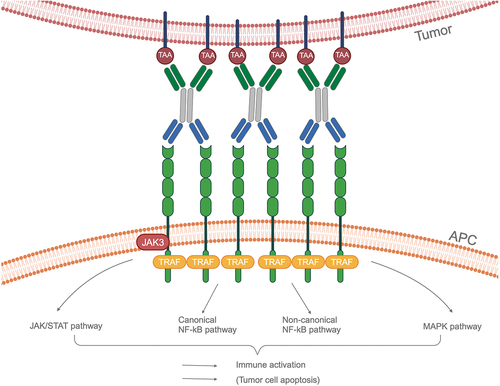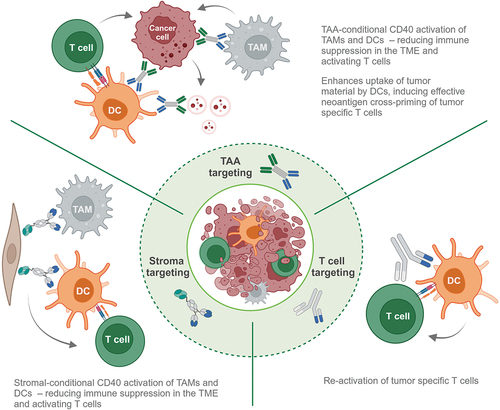Figures & data
Figure 1. Signaling induced by CD40 bispecific antibodies binding tumor-associated antigens. Upon binding to both of its targets, bispecific antibodies promote CD40 supercluster formation, necessary for downstream signaling. The superclusters of CD40 facilitate the recruitment TNF receptor-associated factors (TRAFs, including TRAF1, TRAF2, TRAF3, TRAF5 and TRAF6). The downstream signaling pathways includes the JAK/STAT pathway, canonical or non-canonical NF-κB pathways or MAPK pathway resulting in immune cell activation or tumor cell apoptosis, if occurring within tumor cells. TAA: tumor-associated antigen; APC: antigen-presenting cell. Created with BioRender.com.

Table 1. Monospecific CD40 agonists evaluated in phase 2 studies.
Figure 2. Three different classes of next-generation CD40 targeting therapies based on the nature of their second target. CD40-bispecific antibodies targeting highly expressed tumor associated antigens (TAA), i.e. Neo-X-Prime bispecific antibodies, results in tumor-direct CD40 activation and enhanced uptake of tumor material hence inducing effective neoantigen cross-priming of tumor specific T cells. Stroma-targeting bispecific CD40 antibodies facilitate tumor-directed activation of CD40. Lastly, T cell-targeting CD40 bispecific antibodies allow for re-activation of tumor specific T cells. DC: dendritic cell; TAM: tumor-associated macrophage; TAA: tumor-associated antigen; TME: tumor microenvironment. Created with BioRender.com.

Table 2. CD40 bispecific antibodies in development divided by subclass. Silent Fc, denotes formats containing an IgG derived Fc containing mutations to reduce FcγR interactions.
Figure 3. Effects of CD40 stimulation on immune cells in the tumor microenvironment. CD40 stimulation on cDC1 and cDC2 license the priming and activation of CD8+ and CD4+ T cells, respectively. Further, CD40 activation on either of these cell types allows for the transition into mregDcs, which further can sustain CD8+ T cells. When acting on tumor-associates macrophages, CD40-targeting therapies favor anti-tumor effects both by shifting the TAM population to favor M1-like macrophages and by increasing the tumoricidal effects of M1 macrophages. CD40 activation on B cells induces the formation of tertiary lymphoid structures and induction of antibody production. Lastly, CD40 stimulation on neutrophils within the TME induces its activation and degranulation, hence promoting anti-tumorigenic effects. cDC: conventional dendritic cell; TAM: tumor-associated macrophage; TLS: tertiary lymphoid structure. Created with BioRender.com.

